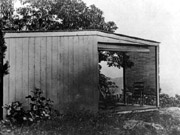 |
||
|
|
 |
|
| The Unmixed Question: the spatial music of Charles Ives |
|
When does a composer become the "sound guy?" Charles Ives's "Unanswered Question" of 1906 was the first piece of the 20th Century using spatial separation as a major element of the composition. He specified three groups of instruments to be placed around the concert hall, or even off-stage. One, a solo trumpet, keeps asking the eternal question; the second, increasingly irate and jabbering winds, tries to respond; and the third, a soothing background of soft strings represents the constant harmony of the universe. This piece influnced many maverick composers, especially 90 year-old Henry Brant, who has composed over 100 spatial works and won the Pulitzer prize last year for "Ice Field" based on this concept. Now imagine you are Charles Ives at the mixing board. Where would you place each instrumental grouping for maximum effect? How does each combination sound different? How do you bring an eternal piece to a satisfying end?
|
||||||||||
|
How to play The Unmixed Question Wait for the music to load and press the Start icon. Clicking "Location" will send the part to another placement in the space once the previous part is finished playing. You can also control the relative volumes of each part or fade them out all together. TIPS Patience pays off. Don't be in a hurry for the sound to change right after the buttons are touched. Just keep your ears open and the changes will follow. Never the same sequence twice. There are 16 parts of all different lengths (four parts possible at once.) Because they are different lengths the phrases will never line up the same way twice. This makes for a slowly evolving piece without an end. The positionings in the space are predetermined. There is no way to force the sound left, right, or to the back of the room. |
|||||||||||||
 |
|||||
| American Mavericks | Archive | About | Contact | Stations | Features | Press | Listening Room | Discussion | Purchase | |||||






